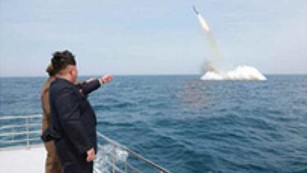12 May 2015
Seoul, South Korea (CNN) -- North Korea could have a fully operational submarine armed with ballistic missiles in the next four to five years, a South Korean defense official said Monday.
The South Korean estimate comes after North Korea said over the weekend that it had successfully test-launched a ballistic missile from a submarine.
Pyongyang's announcement has focused attention on how soon the nuclear-armed regime might reach the capability of being able to launch missiles from submarines, a mobile threat that's difficult to track.
South Korean authorities are suggesting that North Korea's submarine program is still in a relatively early stage.

The Defense Ministry official, who spoke on the condition of anonymity because of the sensitivity of the issue, said Monday that the South Korean military believes the photos of the test launch published in North Korean media are authentic.
But he said the secretive North Korean regime is estimated to need years to develop the submarine and missile technology to have a fully operational system.
'Difficult to defend against'
North Korea's achievement of those goals would create a strategic headache for the United States and its key allies in the region, South Korea and Japan.
"If they can deploy an operational submarine that could launch ballistic missiles armed with nuclear warheads, it would give them a pretty credible second strike capability, and it's difficult to defend against," said Daniel Pinkston, deputy project director for North East Asia at the International Crisis Group.
"It would give them the kind of deterrent that they have said they wish to have," Pinkston said following the reported test launch.
A U.S. official told CNN that Friday's alleged missile test was not a test of a ballistic missile but rather a "simulation of a test."
"This was not a test. It was a simulated firing," the official said.
A second U.S. official said the U.S. is "closely looking" at the possibility the picture of the water ejection behind Kim Jong Un could have been photoshopped. U.S. intelligence officials believe this was -- "at best" -- a test of a submarine missile "ejection system."
Over the weekend a U.S. State Department official said that "launches using ballistic missile technology are a clear violation of multiple U.N. Security Council resolutions."
Approaching 'point of no return'
The exact status of North Korea's nuclear weapons program is murky.
Analysts say Kim Jong Un's regime may well already be able to fit nuclear warheads on ground-launched missiles that can reach South Korea and Japan.
David Albright, a former U.N. weapons inspector, told CNN last week that Pyongyang could have 10 to 15 nuclear weapons at this point and that it could grow that amount by several weapons per year.
North Korea has demanded that the United States recognize it as a nuclear power. But the U.S. government has said North Korean commitment to denuclearization is the starting point for any negotiations between the two sides.
There's no sign that Pyongyang plans to back down on its nuclear program.
"I think we have rapidly approached the point of no return over the past five-years," Joel Wit, a visiting scholar at the U.S.-Korea Institute at Johns Hopkins University, said last week. "This program has gained a lot of momentum over the past few years and not much has been done to stop it."


No comments:
Post a Comment